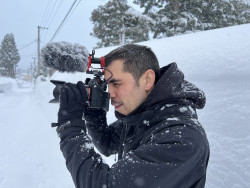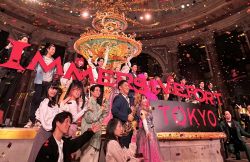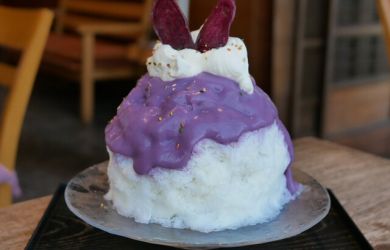
July 22, 2010
Men (And Women) in Black
In their new book Ninja Attack!, authors Hiroko Yoda and Matt Alt lift the mask on Japan’s iconic assassins
By Metropolis
Originally published on metropolis.co.jp on July 2010

SUGITANI ZENJUBO
Birth–Death: Unknown-1573
Occupation: Sniper
Cause of Death: Execution by torture
Gender: Male
A.K.A.: Zenjubo, The Man Who Shot Nobunaga
Known Associates: Rokkaku Yoshikata
Hobbies: Hunting
Preferred Weapon: Japanese Arquebus (matchlock rifle)
Clan Affiliation: Koga
Existence: Confirmed
Illustration by Yutaka Kondo
The Man
The stereotypical ninja eschews firearms for more traditional forms of weaponry such as blades, bludgeons and garrotes. Nothing, however, could be further from the truth. Even in the late 16th century, during the “golden age” of the ninja, they kept close tabs on technological advances in weaponry to keep their repertoires up to date. In fact, the ninja were, if anything, ahead of the curve when it came to the manufacture and employment of explosives, gunpowder and firearms. And when it came to technologically oriented ninja, Koga sniper Sugitani Zenjubo was effectively the poster boy.
Born to one of the 53 families of Koga, Zenjubo was renowned for his sniper skills with the hinawa-ju, or matchlock rifle. So when a local warlord named Rokkaku Yoshikata approached the Koga clan with an audacious plot to assassinate the warlord Oda Nobunaga, there was no question Zenjubo would be picked for the job. In fact the plan was likely hatched with him in mind, as he was already something of a local legend for his ability to consistently take down birds in flight with the finicky, relatively low-velocity matchlock.
The Setup
The medieval equivalent of a presidential assassination, the mission was not for the faint of heart. Zenjubo’s acceptance shows just how far the ambitious ninja was willing to go in the name of duty.
The crafty Oda Nobunaga was far more dangerous prey than anything Zenjubo had encountered, and failure would rain the warlord’s legendary fury down upon anyone even remotely involved. But the Koga ninja had obtained a tantalizing piece of intelligence: Nobunaga’s retinue would pass through the region of Omi that May—and more importantly, they would take the rocky, isolated Chigusa Road to avoid the more direct but tactically exposed Tokaido Road. Travelers inevitably stopped to refresh themselves at Chigusa Pass before pressing onward, and the rough terrain there represented a golden opportunity for an ambush.
Zenjubo arrived many days ahead of Nobunaga’s projected arrival, analyzing the area to determine the best location for his sniper’s nest. He picked a perch overlooking the road, yet largely inaccessible, something that offered both concealment and ease of escape. The latter in particular represented a prime consideration, as the considerable noise and smoke produced by the matchlock’s firing would make the source of the shot painfully obvious.
Alas, no Zapruder-style film exists to document the attempted assassination. But a rough timeline of events has been assembled from several records of the account. On May 19th, 1570, Nobunaga’s procession approached Chigusa Pass as planned.
The Moment of Glory
Zenjubo had taken up his position long before Nobunaga’s retinue ever entered the pass. Positioned with a perfect view of the road, the barrel of his weapon steadied in a makeshift bipod, he waited for his prey with a predator’s calculated patience. Presently the fully armored Nobunaga swung into view, sitting proud atop his horse, flanked by his trusted generals and trailed by his retainers. Zenjubo slowed his breathing as have generations of snipers before and since, taking long pauses between inhales and exhales to clear his mind and steady his aim, firmly fixed upon his quarry’s unprotected face and neck. Forty meters. Thirty. Twenty . . . The sound of thunder cracked the stillness of the alpine air as Zenjubo’s double-shot streaked home.
Zenjubo knew he had precious moments to escape—but still he waited for the smoke to clear. He had to confirm the kill. Through the haze he could make out Nobunaga’s prone form on the rocks below. Mission accomplished . . . wait. No, it couldn’t be. The man was stirring.
Zenjubo had never missed a shot, let alone one from this close. But Nobunaga was struggling back to his feet. He was clutching his neck in obvious pain, but there didn’t seem to be any blood. Zenjubo barely had time to curse his luck before first one, then several arrows began thunking into the trees and dirt around him. Amidst the shouts and hail of projectiles, the ninja sniper leapt from his perch and lowered his head into a dead sprint down his exit route.
The End
Although knocked from his horse by the impact, Nobunaga’s collar armor had absorbed the shots. The furious warlord ordered a manhunt, determined to make an example out of his would-be assassin.
Figuring out the triggerman was the easy part. Few would have had the fortitude to even point their weapons at Nobunaga, let alone pull the trigger. And fewer still would have scored an actual hit. Zenjubo’s almost-success was akin to a personal calling card. But the investigation stagnated for years. This was no run-of-the-mill bandit. Keenly aware of the painful death he faced if captured, Zenjubo went underground to elude the authorities.
He might have eluded them forever if not for an unlucky break. Zenjubo had taken refuge in Amida-ji, a Buddhist monastery located in the territory of Isono Kazumasa, a rival-turned-uneasy-ally of Nobunaga. (Ironically, the monastery had been founded centuries earlier by that proto-ninja of sorts, Prince Shotoku.) When the word of the assassin’s presence somehow leaked out—we’ll never know how—Isono gleefully swooped in. Zenjubo represented a priceless opportunity for the warlord to prove his loyalty and curry favor with the increasingly powerful Nobunaga.
In what could be called an origin of the phrase “getting medieval on your ass,” Nobunaga personally oversaw Zenjubo’s extended execution. He ordered the ninja buried to his neck in sand, and his head slowly removed over the course of many hours (and according to some accounts, days) with deliberately dull-edged blades made of bamboo.

Illustration by Hiroko Yoda
Makibishi
A fiendishly simple and effective form of antipersonnel weapon: spiked objects of a variety of designs scattered along a pathway to lacerate the soles of unwary pursuers. Known as “caltrops” in the Western world, the first Japanese versions were very likely created by drying out the seed-pods of Trapa japonica, a.k.a. the water chestnut plant (which, not coincidentally, also happens to be known abroad as the “water caltrop”).
The geometry of the seed pods is such that their naturally sharp points orient upwards even when tossed, making them extremely hazardous to tread upon in soft-soled footwear (such as the straw zori sandals favored in medieval Japan). Man-made makibishi were forged out of iron with the same principle in mind: four spikes oriented such that no matter how thrown, three form a stable base for the fourth, which points menacingly upward. Ninja enhancements included serrated tips, the better to hook in a wound, and, according to rumor, occasionally were coated in poison.

Illustration by Hiroko Yoda
Manriki-gusari
A distinctive weapon—perhaps “tool” would be a better term—consisting of a length of chain weighted on both ends. Generally kept coiled in a palm or shirtsleeve, the weapon’s weighted end can be hurled at lightning speed from concealment to startle, or even potentially disable, an opponent—and instantly retracted for another strike if necessary thanks to the chain.
The Eyes Have It
In an era before corrective lenses, binoculars, or other forms of visual enhancement, ninja paid exquisite attention to attaining and maintaining their vision. Physical training included rapidly moving between dark and bright spaces (emerging from a shuttered room into the afternoon sunlight, for example) to train their pupils to expand and contract more quickly, staring at candle flames, and counting the number of pinpricks in the sides of paper lanterns. According to unconfirmed reports, they also consumed boiled peppercorns in a belief that the spice improved night vision. The standard “dose” is said to be three a day.

MOCHIZUKI CHIYOJO
Birth–Death: 1530s or 1540s-Unknown
Occupation: Ku-no-ichi
Cause of Death: Unknown
A.K.A.: Mochizuki Chiyome (alternate reading)
Preferred Weapon: A small army of highly trained female ninja
Clan Affiliation: Koga/Takeda
Existence: Confirmed
Illustration by Yutaka Kondo

Ninja Attack! True Tales of Assassins, Samurai, and Outlaws by Hiroko Yoda and Matt Alt (Kodansha International, 2010, 192pp) is available for ¥1,600 at bookstores throughout Japan. Excerpts reproduced with the kind permission of the publisher.
The Woman
Mochizuki Chiyojo has attained legendary status as a female ninja for the simple reason that she remains the only female ninja of whom anything is even vaguely known. It is a fact that females as well as males trained as ninja in times of old. But in the man’s world that was feudal Japan, the personal achievements of women, no matter how compelling, simply weren’t considered on the same level as those of their male counterparts.
Precious little detail about Chiyojo exists in the historical record. Her appearance remains an utter mystery. The precise dates of her birth and death and even the pronunciation of her given name are unclear. It is very likely that she was a descendant of that legendary protector of Koga and all-around ninja innovator, Mochizuki Izumo-no-Kami. In fact, her husband Moritoki, no slouch on the battlefield himself, was a distant relative of Mochizuki’s as well. This ninja pedigree must have come with more than just papers, for after Moritoki’s death in battle in 1561, the shrewd warlord Takeda Shingen took Chiyojo under his wing… and Japanese espionage would never be the same.
The Moment of Glory
Chiyojo earned her place in the history books through her association with Takeda, whose devotion to unconventional warfare—specifically, using ninja to gather information and conduct missions behind enemy lines—was legendary. Realizing the benefits of female as well as male spies, he ordered Chiyojo, who was a distant relative, to secretly build a squad of female intelligence operatives.
Her aruki miko, or “walking maidens,” are the stuff of legend, not to mention adolescent fantasy. Trained “La Femme Nikita”–style in the ways of the world—religion, martial arts and sexuality—they crisscrossed the country in the guise of holy women, entertainers and prostitutes, never arousing suspicion but always keeping an ear to the ground for information of use to their masters. Although miko are mainly associated with Shinto shrines today, in Mochizuki’s era they performed a different role in society. Rather than being assigned to any specific shrine, a miko wandered the country as a sort of shaman or a spirit medium, dispensing advice and wisdom for the locals she met along the way. Many were legitimate holy women, but the looseknit order also proved a perfect cover story for the spies Takeda had Chiyojo train for him.
Young girls orphaned or abandoned in the chaos of the civil war raging through Japan provided Chiyojo with ample human resources for her operation. On the one hand, she rescued these lost souls from almost certain death. On the other, she wasn’t running a charity. Once trained as a walking maiden, returning to a normal life was all but out of the question. It is very likely that any who tried to escape faced brutal discipline or worse. It is logical to assume that only those who could be completely trusted to return would be allowed to wander the countryside completely unchaperoned on their information-gathering missions.
The End
No record remains as to how or when Chiyojo met her end, but the fates of her aruki miko were quite likely short and unpleasant. The image of a well-endowed young maiden whisking away her garments to reveal a hidden arsenal is a seductive one, but this is yet another place where hype has far outpaced reality. In spite of what you may have seen in movies, there is absolutely no evidence that female ninja fought alongside their male counterparts, or even engaged in combat of any kind.
CARNAL COMBAT
Many ku-no-ichi techniques are believed to have been explicitly sexual in nature. The following were postulated by the late, great ninja novelist Futaro Yamada.
- Mushi-tsubo no Jutsu
“The Insect Jar”
Perfect for paternity suits! A technique that allows a woman to choose to have a baby from any partner she’s slept with over the last ten months. - Yadokari
“The Hermit Crab”
Who needs a stork? A technique in which an unborn child can be physically transferred from one woman to another without harm. - Tsutsugarashi
“The Tube-Dryer”
Hard to complain: an assassination technique in which a female causes a man to climax so hard that he dies from the experience. - Tennyougai
“Heavenly Clam”
Practice those Kegel exercises: this is the ability to clamp down and prevent a partner from withdrawing during the act.
- Kesa-gozen
“Her Ladyship’s Vestments”
Swimming upstream? A technique that reverses a man’s (ahem) flow back into his body, killing him instantly. - Fukuro-gaeshi
“Flipping the Bag”
Save on plastic surgery bills! This technique involves removing a developing infant from the womb, altering its features as needed, and safely returning it. - Shokuchu-bana
“Carnivorous Flower”
Bust out the baby wipes: a hypnotic technique in which a man is returned to the mindset of an infant, permanently incapacitating him. - Raneki-gyakunagare
“Reverse Egg Flow”
Shades of The Picture of Dorian Gray? A technique in which, at the moment of climax, a man sees a vision of himself on his deathbed, paralyzing him with fear.







